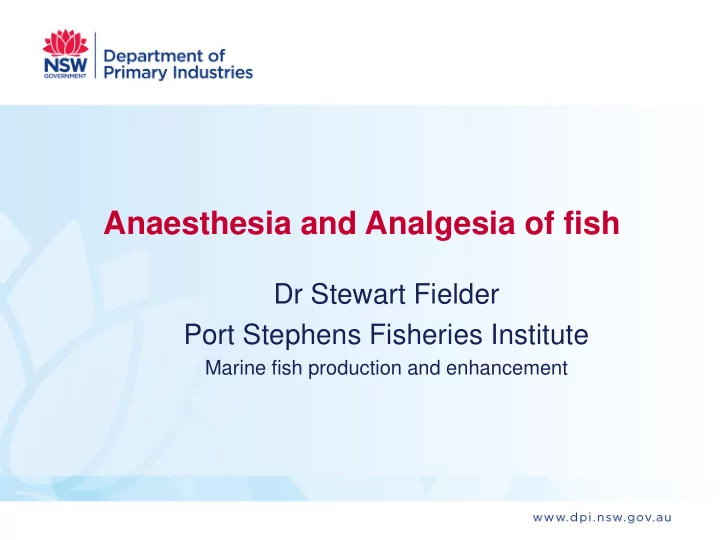

Anaesthesia and Analgesia of fish Dr Stewart Fielder Port Stephens Fisheries Institute Marine fish production and enhancement Name of program
Plan of talk • Who uses anaesthetics for fish • Why anaesthetics are used • When anaesthetics are used • How anaesthetics are used • What types of drugs are used • Preparation and monitoring needed • Euthanasia • Analgesia Name of program
Who uses anaesthetics on fish • Aquaculture (range of procedures) • Fish research (e.g. zebra fish, 600 labs globally) • Public zoos and aquaria wanting to provide improved veterinary care of their fish Name of program
Do fish feel pain? Contentious! Both sides of the argument set the same requirements for pain reception but opinions differ on where the criteria appear phylogenetically and whether or not parallel systems have evolved in different classes and species. Nevertheless, Fish display robust neuroendocrine and physiologic stress responses to noxious stimuli Name of program
Why is chemical restraint needed • Increase safety for fish and handler • Procedures can be done out of water • Reduces movement and physiologic changes in response to pain stimuli • Reduces excitement and hyperactivity related trauma that can occur in routine handling = lowers mortality and morbidity • Decreased movement minimises integuement damage and osmoregulatory disturbances, • Reduces metabolism and oxygen demand and produces less waste (CO2 and ammonia) Name of program
When is anaesthesia used • fish handling • post-harvest transportation • diagnostic procedures • surgery/gavage • artificial breeding broodfish anaesthetised to enable gamete sampling, hormone injection, and egg and milt stripping • euthanasia. Name of program
How are anaesthetics administered • Immersion = inhalation drug ventilated in solution enters bloodstream via gills/skin passes rapidly to CNS Most common method • Parenteral oral ( metomidate only one? ) intravaenous injection Intracoelomic injection Intramuscular injection (hand syringe, pole syringe, darting ) Name of program
Drugs used for IMMERSION anaesthesia • Tricaine methane sulphonate (MS-222) • Benzocaine • Clove Oil, Eugenol, Isoeugenol, Aqui-S • Metomidate • 2-Phenoxyethanol • Quinaldine & Quinaldine sulphate • Azaperone • Medetomidine ( atipamezole 6x dose for recovery ) • Isoflurane and Halthane • Oxygen (for some sharks) Name of program
Drugs used for PARENTERAL anaesthesia • Ketamine (IM, IV) • Medetomidine + ketamine (IM; atipamezole for recovery in some sharks ) • Xylazine + ketamine (IM) • Propofol (IV) • Alfaxolone/Alfadolone (for sensory physiology) Name of program
Why select a particular anaesthetic • Efficacy (rate of induction/recovery, margin of safety, adverse responses) • Ease of use – administration ( mixing, water solubility, pH ) disposal • Toxicity to users • Cost Most widely used immersion anaesthetic (isoeugenol) Name of program
Aqui-S advantages • Approved in Australia, NZ, Norway, Korea, Costa Rica, Honduras with Zero withholding period • Soluble in freshwater and seawater • Effective at low concentration 5-20mg/L • Sedative effects detected at low concentrations • Wide margin of safety – fish can remain in treatment for long periods of time • Limited adverse response • Fast recovery • Cost effective Name of program
Levels of anaesthesia in fish From Barker et al., 2009 Name of program
Essential preanaesthetic preparation 1. Baseline behavioural parameters (ventilation, caudal fin stroke rate, overall activity level, schooling behaviour) 2. No food for 12-24 h – limits regurgitation (clogs gills / nitrogenous waste) 3. Containers with adequate water for transportation, induction, maintenance, recovery, possible water changes 4. Water quality same as source water (DO, pH, temp, salinity) 5. Out of water plan to prevent drying (skin, fins, eyes) 6. PPE (masks for powders, gloves) Name of program
Monitoring Anaesthetic depth (e.g. activity, reaction to stimuli, equilibrium, jaw tone, muscle tone, caudal fin strokes, swimming, respiratory rate) • Usually occurs within 5-10 minutes • often a short excitement phase during immersion; coughing reflex Cardiopulmonary Activity (can be monitored with cardiac ultrasonography, Doppler flow probes, ECG; blood gas sampling for O2, CO2 and pH) Water Quality (DO, pH, temp, ammonia) Recovery (occurs when fish returned to aerated, anaesthetic-free water; often 5-10min; might show excitement phase – protect fish and handler) Resuscitation (may require forward movement through water or irrigation of gills) Name of program
Sedation (5 ppm Aqui-S) Name of program
Light anaesthesia (10 ppm Aqui-S) Name of program
Heavy (surgical) anaesthesia (20 ppm Aqui-S) Gavaging medicated feed Name of program
Euthanasia Overdose of immobilization drug is usually acceptable • Mostly use Immersion drugs MS-222 and benzocaine at 5 -10x anaesthetic concentration • Large fish - poured onto gills • Maintaining fish in solution 5-10 mins after cessation of opercular movement = expired • Cardiac asystole lags behind brain death (myocardial cells use local glycogen stores) • Or cranial concussion, pithing, spinal transection, exsanguination used in deeply anaesthetised fish Name of program
Analgesia Limited information is available about the use of analgesics in fish • Drugs listed as anaesthetics are often assumed to provide analgaesia if they result in complete immobilisation of the fish but depends on drug property – caution needed! • Some studies with morphine (rainbow trout) and butorphanol (koi carp) have shown some analgaesic or at least antinociceptive action Name of program
ACEC Guideline NSW Fisheries http://www.dpi.nsw.gov.au/__data/assets/pdf_file/0010/114976/ACEC-Guide-2009- Name of program FINAL-VERSION.pdf
Recommend
More recommend